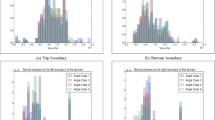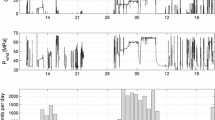Abstract
The knowledge of fracture properties and its geometrical patterns is often required for the analysis of mechanical and flow properties in fractured reservoirs, as fracture characterization plays a critical role in the optimization of hydrocarbon production or estimation of storage capacity of subsurface reservoirs. A stochastic method based on a Markov chain Monte Carlo (MCMC) algorithm is proposed to estimate fracture properties using a rock physics model for fractured rocks. Two implementations are presented: a Metropolis algorithm based on a Gaussian prior distribution and an extended Metropolis algorithm with an informative prior obtained from multiple-point statistics simulations. The results are compared to a Bayesian analytical approach where the solution is based on a linearized approximation of the rock physics model. The novelty of the proposed approach is the use of a training image, that is, a conceptual geological model, to account for the spatial distribution of the fractures. Two fracture properties are considered, namely fracture density and aspect ratio, and the spatial distribution and geometrical characteristics of fractures are also investigated to understand the connectivity patterns that control fluid flow. The MCMC approach with a training image is more computationally demanding but provides geometrical models of the spatial distribution of fractures. The inversion results show that the prediction accuracy of fracture density and aspect ratio obtained by the MCMC methods is similar to the one obtained with the analytical approach, and that the MCMC methods provide a reliable assessment of the posterior uncertainty as well.

















Similar content being viewed by others
References
Baek SH, Kim SS, Kwon JS, Um ES (2017) Ground penetrating radar for fracture mapping in underground hazardous waste disposal sites: a case study from an underground research tunnel, South Korea. J Appl Geophys 141:24–33
Bakulin A, Grechka V, Tsvankin I (2000) Estimation of fracture properties from reflection seismic data—part I: HTI model due to a single fracture set. Geophysics 65(6):1788–1802
Blei DM, Kucukelbir A, McAuliffe JD (2017) Variational inference: a review for statisticians. J Am Stat Assoc 112(518):859–877
Buland A, Omre H (2003) Bayesian linearized AVO inversion. Geophysics 68(1):185–198
Byun H, Kim J, Yoon D, Kang II, Song J (2021) A deep convolutional neural network for rock fracture image segmentation. Earth Sci Inf 14:1937–1951
Chandna A, Srinivasan S (2023) Probabilistic integration of geomechanical and geostatistical inferences for mapping natural fracture networks. Math Geosci 55:645–671
Chopra S, Marfurt KJ (2007) Volumetric curvature attributes for fault/fracture characterization. First Break 25(7):35–46
Feng R, Grana D, Balling N (2021) Variational inference in Bayesian neural network for well-log prediction. Geophysics 86(3):M91–M99
Gelman A, Carlin JB, Stern HS, Dunson DB, Vehtari A, Rubin DB (2013) Bayesian data analysis. CRC Press
Gillespie PA, Howard CB, Walsh JJ, Watterson J (1993) Measurement and characterization of spatial distributions of fracture. Tectonophysics 226(1–4):113–141
Goodwin H, Aker E, Røe P (2022) Stochastic modeling of subseismic faults conditioned on displacement and orientation maps. Math Geosci 54:207–224
Grana D (2016) Bayesian linearized rock-physics inversion. Geophysics 81(6):D625–D641
Grana D, Mukerji M, Doyen P (2021) Seismic reservoir modeling. Wiley
Grana D, de Figueiredo L, Mosegaard K (2022) Markov chain Monte Carlo for petrophysical inversion. Geophysics 87(1):M13–M24
Gravey M, Mariethoz G (2020) QuickSampling v1.0: a robust and simplified pixel-based multiple-point simulation approach. Geosci Model Dev 13:2611–2630
Grechka V, Tsvankin I (2003) Feasibility of seismic characterization of multiple fracture sets. Geophysics 68(4):1399–1407
Hansen TM, Cordua KS, Mosegaard K (2012) Inverse problems with non-trivial priors: efficient solution through sequential Gibbs sampling. Comput Geosci 16:593–611
Hansen TM, Cordua KS, Looms MC, Mosegaard K (2013) SIPPI: a Matlab toolbox for sampling the solution to inverse problems with complex prior information Part 1—methodology. Comput Geosci 52:470–480
Hastings WK (1970) Monte Carlo sampling methods using Markov chains and their application. Biometrika 57(1):97–109
Healy D, Rizzo RE, Cornwell DG, Farrell NJC, Watkins H, Timms NE, Gomez-Rivas E, Smith M (2017) FracPaQ: a MATLAB™ toolbox for the quantification of fracture patterns. J Struct Geol 95:1–16
Huang L, Dong X, Clee TE (2017) A scalable deep learning platform for identifying geologic features from seismic attributes. Lead Edge 36(3):249–256
Hudson JA (1981) Wave speeds and attenuation of elastic waves in material containing cracks. Geophys J R Astr Soc 64:133–150
Kolyukhin D (2022) Sensitivity analysis of discrete fracture network connectivity characteristics. Math Geosci 54:225–241
Lei Q, Latham JP, Tsang CF (2017) The use of discrete fracture networks for modelling coupled geomechanical and hydrological behaviour of fractured rocks. Comput Geotech 85:151–176
Li T, Wang R, Wang Z, Zhao M, Li L (2018) Prediction of fracture density using genetic algorithm support vector machine based on acoustic logging data. Geophysics 83(2):D49–D60
Li T, Wang Z, Yu N, Wang R, Wang Y (2020) Numerical study of pore structure effects on acoustic logging data in the borehole environment. Fractals 28(03):2050049
Li T, Wang Z, Wang R, Yu N (2021) Pore type identification in carbonate rocks using convolutional neural network based on acoustic logging data. Neural Comput Appl 33:4151–4163
Ma Z, Yin X, Zong Z (2022) Fracture parameters estimation from azimuthal seismic data in orthorhombic medium. J Nat Gas Sci Eng 100:104470
March R, Doster F, Geiger S (2018) Assessment of CO2 storage potential in naturally fractured reservoirs with dual-porosity models. Water Resour Res 54:1650–1668
Mariethoz G, Renard P, Caers J (2010) Bayesian inverse problem and optimization with iterative spatial resampling. Water Resour Res 46(11):W11530
Mavko G, Mukerji T, Dvorkin J (2010) The rock physics handbook: tools for seismic analysis of porous media. Cambridge University Press
Mosegaard K, Tarantola A (1995) Monte Carlo sampling of solutions to inverse problems. J Geophys Res 100(B7):12431–12447
Pradhan A, Mukerji T (2020) Seismic Bayesian evidential learning: estimation and uncertainty quantification of sub-resolution reservoir properties. Comput Geosci 24:1121–1140
Rüger A (2002) Reflection coefficients and azimuthal AVO analysis in anisotropic media. Society of Exploration Geophysics, Tulsa
Sambridge M, Mosegaard K (2002) Monte Carlo methods in geophysical inverse problems. Rev Geophys. https://doi.org/10.1029/2000RG000089
Sava D (2004) Quantitative data integration for fracture characterization using statistical rock physics. Stanford University, California
Shen F, Zhu X, Toksöz MN (2002) Effects of fractures on NMO velocities and P-wave azimuthal AVO response. Geophysics 67(3):711–726
Tao Z, Alves TM (2019) Impacts of data sampling on the interpretation of normal fault propagation and segment linkage. Tectonophysics 762:79–96
Tarantola A (2005) Inverse problem theory and methods for model parameter estimation. SIAM, Philadelphia
Thachaparambil MV (2015) Discrete 3D fracture network extraction and characterization from 3D seismic data—a case study at Teapot Dome. Interpretation 3(3):ST29–ST41
Thomsen L (1986) Weak elastic anisotropy. Geophysics 51:1954–1966
Udegbe E, Morgan E, Srinivasan S (2019) Big data analytics for seismic fracture identification using amplitude-based statistics. Comput Geosci 23:1277–1291
Wu J, Boucher A, Zhang T (2008) A SGeMS code for pattern simulation of continuous and categorical variables: FILTERSIM. Comput Geosci 34:1863–1876
Yasin Q, Ding Y, Baklouti S, Boateng CD, Du Q, Golsanami N (2022) An integrated fracture parameter prediction and characterization method in deeply-buried carbonate reservoirs based on deep neural network. J Petrol Sci Eng 208:109346
Acknowledgements
This research is sponsored by the LOCRETA project under the DHRTC consortium. We also acknowledge the sponsors of SCERF.
Author information
Authors and Affiliations
Corresponding author
Ethics declarations
Conflict of interest
The authors declare no conflict of interest.
Appendix A: Hudson’s Model
Appendix A: Hudson’s Model
Hudson’s model is based on effective medium theory, in which an elastic solid is assumed to include thin, penny-shaped cracks filled with fluid (Hudson 1981; Sava 2004). Physical properties of the inclusions, namely fracture density (\(e\)) and aspect ratio (\(\alpha\)), are used to describe the fracture systems. According to the first-order Hudson’s model (Hudson 1981; Sava 2004), the elastic rock properties of the fractured medium can then be calculated from the components of the stiffness tensor as
where
with \(\lambda\) and \(\mu\) being the Lamé parameters of the unfractured host (background) rock; \(K_{fl}\) being the bulk modulus of the inclusion fluid material; and \(\rho_{h}\) and \(\rho_{fl}\) being the density of the background rock and inclusion fluid, respectively. The rock porosity (\(\phi\)) caused by the presence of cracks is given by
Based on Hudson’s rock physics model, the reflection coefficients for seismic modeling are then calculated using the Aki–Richards equation (Buland and Omre 2003)
where \(\theta\) is the incidence angle; \(V_{P} \left( t \right)\), \(V_{S} \left( t \right)\), and \(\rho \left( t \right)\) are the time-dependent rock properties; and \(\gamma\) is the \(V_{P} /V_{S}\) ratio. A convolution operator is then adopted to compute the seismic signal assuming a known source wavelet.
Rights and permissions
Springer Nature or its licensor (e.g. a society or other partner) holds exclusive rights to this article under a publishing agreement with the author(s) or other rightsholder(s); author self-archiving of the accepted manuscript version of this article is solely governed by the terms of such publishing agreement and applicable law.
About this article
Cite this article
Feng, R., Mosegaard, K., Mukerji, T. et al. Estimation of Reservoir Fracture Properties from Seismic Data Using Markov Chain Monte Carlo Methods. Math Geosci (2024). https://doi.org/10.1007/s11004-023-10129-y
Received:
Accepted:
Published:
DOI: https://doi.org/10.1007/s11004-023-10129-y




